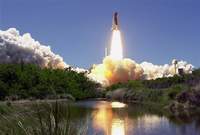Discovery's mission endangers NASA's image and US national space industry
On Saturday and Sunday - for two days in a row - NASA had to postpone the launch of the shuttle Discovery due to poor weather. Another launch attempt was planned for July 4th. Some specialists are openly ill at ease as the launch date draws nearer. They are mostly concerned about the mission safety. Others hope that things will run smoothly this time.

Given the two horrible disasters that claimed the lives of 13 astronauts, the safety concerns are quite understandable. The space shuttle Challenger blew up while lifting off in 1986. On February 1, 2003, the space shuttle Columbia went down in flames during a reentry. Several authoritative engineers argue safety improvements are still not good enough for minimizing the potential threat.
Pieces of foam insulation flying off an external fuel tank are thought to have damaged the shell of the shuttle Columbia in 2003. Subsequently, NASA imposed a ban on the use of the three remaining shuttles. It took NASA engineers two years and a half to carry out necessary tank modifications. Finally, last July Discovery lifted off with a redesigned fuel tank. Yet again, a section of the foam insulation flew off the tank during the shuttle’s ascent. Fortunately, no damage was done. Engineers needed another year to redesign the external fuel tank once again. Eventually, the safety improvements took more than three years to complete. Aside from redesigning the fuel tank twice, NASA experts and engineers also modified the blow-out system and reinforced heat insulation. They also drew up a plan for conducting in-orbit repairs. But the main question remains: Were the risks minimized significantly?
We asked one of the Russian rocket designers to comment on the issue. He said the shuttle’s design flaws simply cannot be fixed. No matter how ghastly the prospects may seem, one needs to admit that the crew will be doomed to destruction should a serious accident occur during a liftoff or landing. The space shuttle has no emergency rescue system similar to that installed on the Russian-made boosters of Soyuz class. Even if a booster catches fire during launch, special engines mounted on its tip will propel the Soyuz along with a manned capsule to a considerable altitude. After separating an orbital compartment, a return capsule with the crew will descend by parachute and land at a safe distance from the site of an accident. In September 1983, the rescue system saved a crew of two Soviet cosmonauts – Vladimir Titov and Gennady Strekalov – after a 40-meter booster went ablaze shortly before the launch.
Using a parachute (with a standby cupola on hand) for the return of a crew to Earth is a lot safer than landing the shuttle. An emergency rescue system is, without doubt, a must for the shuttle. But it cannot be used on the shuttle due to design limitations.
By and large, the shuttle-type space vehicles, which in the early 1980s were described by U.S. media as an “impressive breakthrough” and a “milestone in the development of space technology and exploration,” turned out to be a major misconception. Each launch of the shuttle costs NASA in the neighborhood of half a billion U.S. dollars. The estimated cost of 114 launches is $60 billion. In contrast with the above figures, one launch of the Soyuz booster carrying manned mission costs from $35 million to $40 million, or 10 to 14 times less than the shuttle’s launch regular costs. Last fall NASA administrator dumbfounded the public by saying that the shuttle program and the International Space Station were the mistakes, and 30 years were just wasted away.
In any case, NASA is going to put the shuttle out of action in three-and-a-half or four-year time. But today the shuttle program is essential for completing the building of the ISS. Fore more than three years Russia had to deliver crews to the station and bring them back to Earth on its own. Besides, Russian boosters also delivered supplies and equipment to the ISS during the above period. In a face-saving move, NASA is resuming the shuttle spaceflights though some opponents regard the decision as premature.
NASA Flight Safety Manager Brian O’Connor was opposed to the launch while signing a flight readiness certificate. However, he did not insist that the launch be called off. In a statement to the press, he said that “the crew will have a chance to relocate to a safe place in case of emergency” (he was apparently referring to the crew being able to move to the ISS and wait for the arrival of another shuttle should an emergency occur during the upcoming mission - Trud). “We shouldn’t let the shuttle to be irretrievably lost during the mission, as far as I’m concerned. But the majority of experts in this room agree that hazard level for the crew is within acceptable limits. If NASA administrator finds that hazard level acceptable – well, I’m not going to run against the grain,” said O’Connor.
Engineers had earlier found cracks in the foam insulation enclosing the metal brackets. As it turned out, it was impossible to eliminate the cracks and fix the design flaws to meet the deadline. As a result, the foam was removed from the brackets that hold the pressure main lines. Only a real flight will show whether the move was worthwhile.
By the bye, there has not been any test filling of Discovery’s external fuel tank with liquid hydrogen and liquid oxygen as the shuttle sat on the launch pad. In light of complete replacement of the faulty gauges on the tank, the tank should have been filled with fuel. The gauges problem led to a postponement of the shuttle launch from May to July. Looks like engineers decided to test the troublesome foam insulation as little as possible…
NASA managers drew up the following contingency plan: the astronauts are to board the ISS and wait for another shuttle should they fail to repair Discovery in open space. On the face of it, the plan looks quite reasonable. On the other hand, a rescue mission could be a major problem if the second shuttle gets damaged during a liftoff. Needless to say, Russia will be ready to give a helping hand under the circumstances. At least three additional Soyuz booster rockets will be required to carry out an emergency evacuation of seven station “non-crew” members i.e. the Discovery astronauts. Such a number of manned spaceships are not available in Russia at the moment.
The launch of the shuttle Discovery had been originally scheduled for Saturday, July 1st, at about 4 p.m. ET. It was postponed until Sunday due to poor weather conditions. However, NASA had to call off a Sunday launch attempt too because the skies did not clear in time for liftoff. This mission’s launch window that began on Saturday extends until July 19th.
Discovery’s 12-day mission is aimed at testing safety improvements made to the shuttle. Discovery will also replenish the ISS with supplies and equipment. The shuttle will drop off a third station crew member. The mission is going to be the 115th flight of the U.S. space shuttles and Discovery’s 32nd flight.
Trud
Translated by Guerman Grachev
Pravda.Ru
Discuss this article on Pravda.Ru English Forum
Subscribe to Pravda.Ru Telegram channel, Facebook, RSS!



